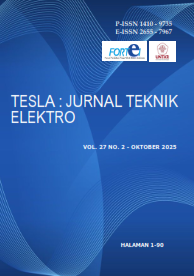COMPARATIVE ANALYSIS OF MOTHER WAVELET FOR VOLTAGE SAG AND SWELL CLASSIFICATION USING DISCRETE WAVELET TRANSFORM (DWT) AND RADIAL BASIS FUNCTION NEURAL NETWORK (RBFNN)
Main Article Content
Abstract
Power quality disturbances, such as voltage sag and swell, can lead to system instability and equipment damage. In this study, identification is defined as the process of detecting the presence and characteristics of these disturbances through time-frequency feature extraction using the Discrete Wavelet Transform (DWT). A Radial Basis Function Neural Network (RBFNN) is then employed as the classification method to determine the specific type of disturbance (sag or swell).The need for an automated identification and classification system arises because manual monitoring is slow and subjective, whereas industrial applications require rapid decisions based on measurable metrics. The disturbance dataset, specifically comprising voltage sag and voltage swell, was generated through modeling and simulation using MATLAB/Simulink. Features were extracted from the disturbance signals by decomposing them up to 7 levels with the DWT, using four different Mother Wavelets: Daubechies-4 (db4), Haar, Symlet-4 (sym4), and Coiflet-4 (coif4). These feature datasets were then normalized and divided into training, validation, and testing sets to train and evaluate the RBFNN model. Performance was assessed based on Mean Squared Error (MSE), classification accuracy, and the confusion matrix as objective success criteria. The results indicate that all models successfully achieved an MSE below 10-5 and 100% accuracy on the test data, signifying a very low error rate. The model utilizing the Haar wavelet demonstrated the best training efficiency, requiring the fewest epochs. Therefore, this combination is highly recommended for practical power quality monitoring applications
Abstrak
Gangguan kualitas daya , seperti Voltage Sag, dan Swell, dapat menyebabkan ketidakstabilan sistem dan kerusakan pada peralatan. Identifikasi pada penelitian ini didefenisikan sebagai proses mendeteksi keberadaan dan karakteristik gangguan melalui ekstraksi fitur waktu- frekuensi menggunakan Discrete Wavelet Transform (DWT) dan Radial Basis Function Neural Network (RBFNN) sebagai metode klasifikasi untuk proses menentukan jenis gangguan (sag dan swell). Kebutuhan akan sistem identifikasi dan klasifikasi otomatis diperlukan karena pemantauan manual bersifat lambat dan subjektif, sementara industri memerlukan keputusan cepat berbasis metrik yang terukur. Dataset gangguan, yang secara spesifik mencakup Voltage Sag dan Voltage Swell, dihasilkan melalui pemodelan dan simulasi dengan perangkat lunak MATLAB/Simulink. Fitur dari sinyal gangguan ini diekstraksi dari dekomposisi Discrete Wavelet Transform (DWT) hingga 7 level, dengan empat variasi Mother Wavelet (Daubechies-4, Haar, Symlet-4, dan Coiflet-4). Data fitur tersebut kemudian dinormalisasi dan dibagi menjadi data training, validation dan testing, untuk melatih dan menguji model RBFNN, yang kinerjanya dievaluasi berdasarkan Mean Squared Error (MSE), akurasi klasifikasi dan confusion matrix sebagai kriteria objektif keberhasilan. Hasil penelitian menunjukkan bahwa semua model berhasil mencapai MSE di bawah 10⁻⁵ dan akurasi 100% pada data uji, yang mengindikasikan tingkat kesalahan sangat rendah. Model berbasis wavelet Haar menunjukkan efisiensi pelatihan terbaik dengan jumlah epoch paling sedikit. Oleh karena itu, kombinasi ini sangat direkomendasikan untuk aplikasi pemantauan kualitas daya
Article Details

This work is licensed under a Creative Commons Attribution-ShareAlike 4.0 International License.
This work is licensed under a TESLA: Jurnal Teknik Elektro Creative Commons Attribution-ShareAlike 4.0 International License. 
References
[1] F. Z. Dekhandji, Detection of power quality disturbances using discrete wavelet transform, 2017 6th International Conference on Systems and Control (ICSC) (2017).
[2] H. Jain and S. K. Gawre, Detection and classification of current interruptions and transients by using wavelet transform and neural network, 2016 International Conference on Electrical, Electronics, and Optimization Techniques (ICEEOT) (2016).
[3] S. Alshahrani, M. Abbod, B. Alamri, and G. Taylor, Evaluation and classification of power quality disturbances based on discrete wavelet transform and artificial neural networks, 2015 International Conference on Smart Grid and Clean Energy Technologies (ICSGCE) (2015).
[4] V. Wahyuningrum, Penerapan radial basis function neural network dalam pengklasifikasian daerah tertinggal di Indonesia, Jurnal Aplikasi Statistika & Komputasi Statistik, 12 (1) (2020), 37.
[5] I. G. D. Arjana, Identifikasi penurunan kwalitas daya pada penyulang menggunakan kombinasi transformasi wavelet dan neural network, Majalah Ilmiah Teknologi Elektro, 9 (1) (2010).
[6] A. K. Sharma, O. P. Mahela, and S. R. Ola, Detection of power quality disturbances using discrete wavelet transform, 2016 IEEE 1st International Conference on Power Electronics, Intelligent Control and Energy Systems (ICPEICES) (2016).
[7] P. Patil, K. Muley, and R. Agrawal, Identification of power quality disturbance using neural network, 2019 3rd International Conference on Trends in Electronics and Informatics (ICOEI) (2019).
[8] A. A. Aryaguna, D. O. Anggriawan, and T. Elektro Industri, Identifikasi jenis gangguan pada jaringan distribusi menggunakan metode artificial neural network, Jurnal Inovtek Seri Elektro, 3 (1) (2021).
[9] S. G. Mallat, A theory for multiresolution signal decomposition: The wavelet representation, IEEE Transactions on Pattern Analysis and Machine Intelligence, 11 (7) (1989).
[10] J. Mathew, N. Sivakumaran, and P. A. Karthick, Automated detection of seizure types from the higher-order moments of maximal overlap wavelet distribution, Diagnostics, 13 (4) (2023).
[11] A. Géron, Hands-On Machine Learning with Scikit-Learn, Keras, and TensorFlow: Concepts, Tools, and Techniques to Build Intelligent Systems, O’Reilly Media, Inc. (2019).
[12] X. Liu, N. Li, S. Liu, J. Wang, N. Zhang, X. Zheng, K.-S. Leung, and L. Cheng, Normalization methods for the analysis of unbalanced transcriptome data: A review, Frontiers in Bioengineering and Biotechnology, 7 (2019).
[13] M. Madhiarasan, Accurate prediction of different forecast horizons wind speed using a recursive radial basis function neural network, Protection and Control of Modern Power Systems, 5 (1) (2020), 22.
[14] I. Kopal, M. Harničárová, J. Valíček, J. Krmela, and O. Lukáč, Radial basis function neural network-based modeling of the dynamic thermo-mechanical response and damping behavior of thermoplastic elastomer systems, Polymers, 11 (6) (2019), 1074.



